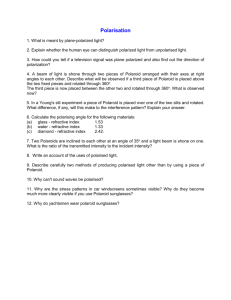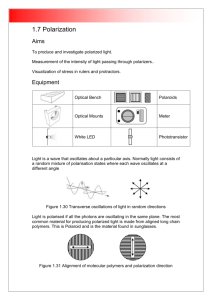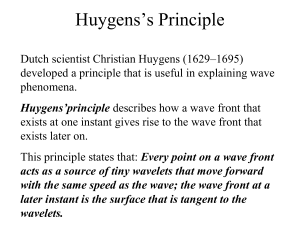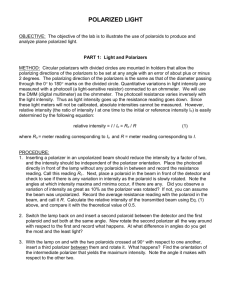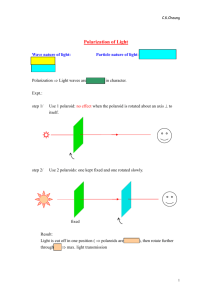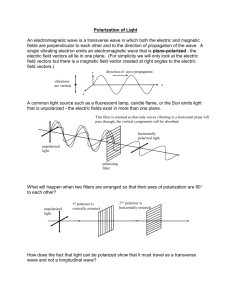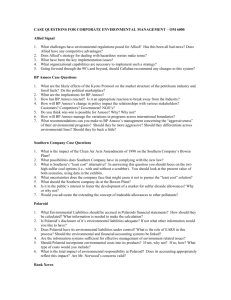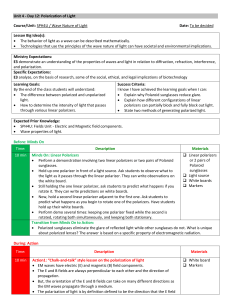polarization diagram
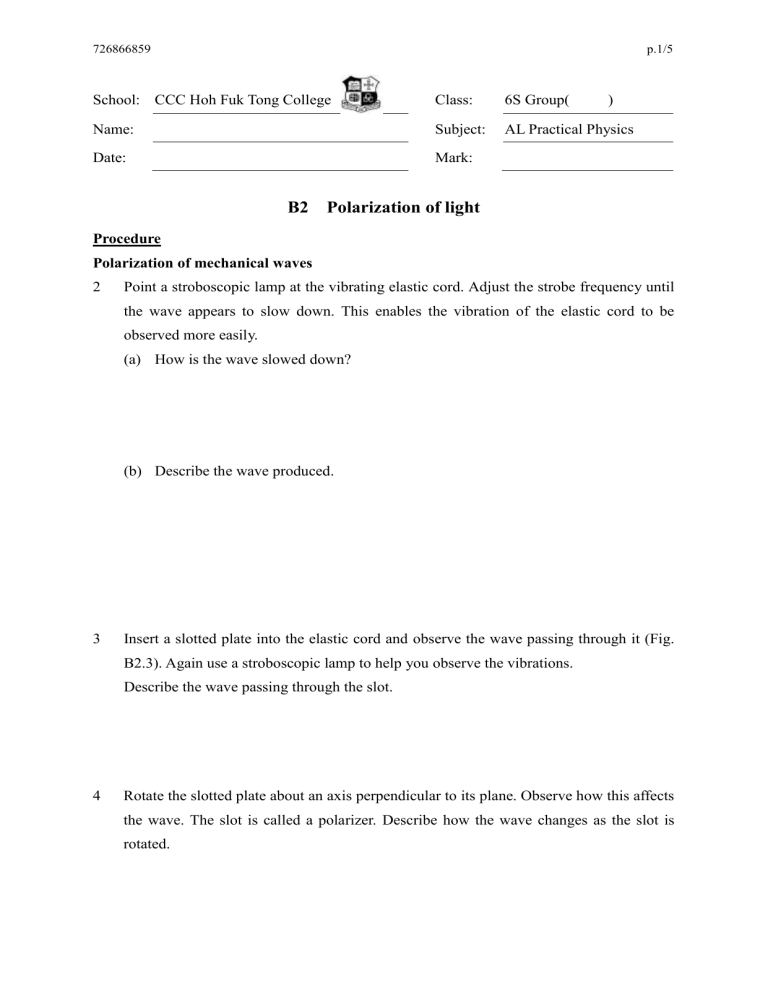
726866859 p.1/5
School: CCC Hoh Fuk Tong College
Name:
Date:
Class: 6S Group( )
Subject: AL Practical Physics
Mark:
B2 Polarization of light
Procedure
Polarization of mechanical waves
2 Point a stroboscopic lamp at the vibrating elastic cord. Adjust the strobe frequency until the wave appears to slow down. This enables the vibration of the elastic cord to be observed more easily.
(a) How is the wave slowed down?
(b) Describe the wave produced.
3 Insert a slotted plate into the elastic cord and observe the wave passing through it (Fig.
B2.3). Again use a stroboscopic lamp to help you observe the vibrations.
Describe the wave passing through the slot.
4 Rotate the slotted plate about an axis perpendicular to its plane. Observe how this affects the wave. The slot is called a polarizer. Describe how the wave changes as the slot is rotated.
726866859 p.2/5
5 Insert another slotted plate into the elastic cord with its slot parallel to that of the first plate. Slowly rotate the second plate through 90 ° and observe what happens. The second slotted plate is called an analyzer. Describe what happens to the wave.
Polarization of light
6 Overlap 2 Polaroids and note the light passing through them (Fig. B2.4). Rotate one
Polaroid about an axis perpendicular to its plane. Observe how the intensity of the transmitted light is affected. Describe how the intensity of the transmitted light is affected.
7 The first sheet is called a polarizer and the second sheet an analyzer. The two Polaroids are said to be crossed if no light is transmitted through them. What are the functions of the polarizer and the analyzer?
8 To check if a certain light is polarized, look at it through a rotating Polaroid.
What is observed if the light is (a) unpolarized, (b) completely polarized, (c) partially polarized?
726866859 p.3/5
9 With 2 Polaroids crossed, insert a third one between them. Rotate the middle Polaroid and observe what happens. Explain why the combination allows light to pass through for most positions of the middle Polaroid.
Polarized light by reflection
10 Look through a Polaroid at reflected light from a bench top, a glass window, an aluminium foil, a water surface, etc. Rotate the Polaroid and look for any change in the intensity of the transmitted light. Is the reflected light from the different surfaces unpolarized, completely polarized or partially polarized?
11 Look at the reflected light from different surfaces through a pair of polaroid sun-glasses.
What do the polaroid sun-glasses do to the reflected light? Explain.
Polarized light by scattering
12 Look at the clear blue sky through a rotating Polaroid. Is the light from the blue sky polarized? Why?
13 Add a few drops of milk to the water in a tank. Project a beam of light through the water
(Fig. B2.5). Using a Polaroid, examine the scattered light in the directions A and B. Also
726866859 p.4/5 examine the transmitted light in the direction C.
Describe with the aid of a diagram the polarization, if any, of the light in the directions A,
B and C. Explain why polarization occurs in the directions observed.
Liquid crystal display (LCD)
14 Place a Polaroid over the liquid crystal display (LCD) of a digital watch or a calculator
(Fig. B2.6). Rotate the Polaroid and observe what happens. Describe and explain what happens.
A simple stress analysis
15 Set up two Polaroids horizontally on an overhead projector, leaving a gap between them.
Hold a strip of adhesive tape between the two Polaroids and apply a force to stretch it
(Fig. B2.7). Describe what happens.
726866859 p.5/5
16 Repeat by stretching a strip of tape with notches cut on its sides and another one with a hole punched through its centre (Fig. B2.8). Describe what happens.
